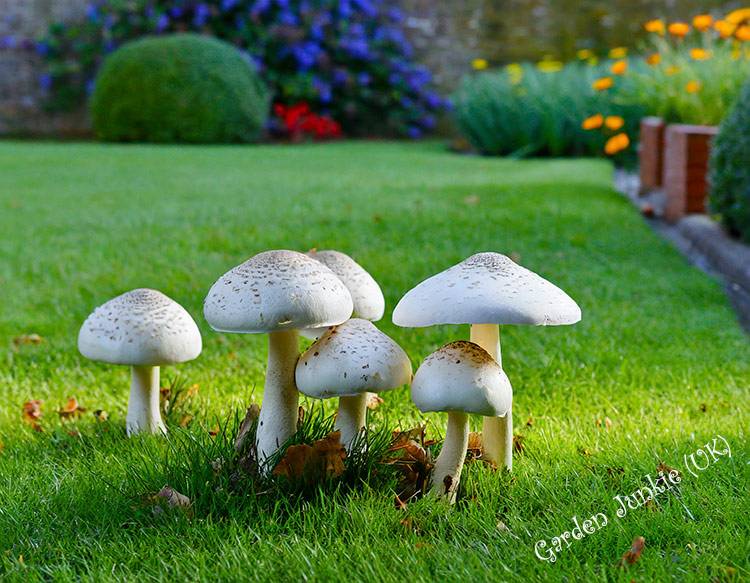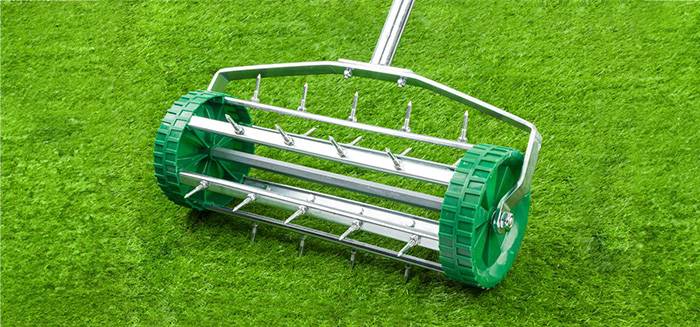Beautiful Plants For Your Interior
How to Get Rid of Mushrooms in The Lawn

I am often asked, how to get rid of mushrooms in the lawn. Mushrooms are a common problem in many UK lawns, and while they can be unsightly, most are not typically harmful (poisonous) to humans, but if left untreated they may damage your lawn further by spreading other fungi-related diseases, and eventually, your lawn may die off.
It should be noted however, that there are some cases where mushrooms can be a serious health hazard when they grow in areas where children play and or domestic animals are allowed to wander for instance.
If you are concerned about mushrooms growing in your lawn, then there are several ways to remove them safely and effectively as we shall see in this post.
VERY IMPORTANT: Don’t eat any mushrooms mentioned in this post despite them possibly being labelled as edible or harmless. It’s extremely easy to misidentify a poisonous mushroom.
Mushrooms are fungi that grow on decaying organic matter, such as dead leaves, grass clippings, or wood. They can be identified by their characteristic shape, size, and colour. Some common types of mushrooms that grow in grass may include:
- Common Ink Cap (Coprinopsis atramentaria)
- Fairy Rings (Marasmius oreades)
- The Blusher (Amanita rubescens)
- Shaggy Ink Cap (Coprinus comatus)
- Fool’s Funnel (Clitocybe rivulosa)
It is important to be able to identify mushrooms correctly, as some types can be extremely poisonous. If you are not sure what type of mushroom you have found, it is best to leave it well alone and certainly not eat it and perhaps get help and guidance from your local garden centre proffesional.
If you are interested in ‘mushrooms generally’ as food then take a look at this site.
How to Get Rid of Mushrooms in The Lawn: Various Methods Explained
Causes of Mushrooms in Grass
There are many reasons why mushrooms may grow on your lawn. Some of the most common causes include:
- Moisture: Mushrooms thrive in moist conditions, so they are more likely to grow in lawns that are watered frequently or that receive a lot of rain.
- Shade: Mushrooms also prefer shady areas, so they are more likely to grow in lawns that are not exposed to direct sunlight.
- Nutrients: Mushrooms need nutrients to grow, and they can get these nutrients from the decaying organic matter in the soil.
- Disease: Some lawn diseases can cause mushrooms to grow in grass.
How to Safely Remove Mushrooms From Grass
Once you have identified the type of mushroom, you can begin the removal process. Several methods can be used, depending on the size and location of the mushrooms.
You can try to remove mushrooms from the grass by using a lawnmower. This is a quick and easy method, but it is not always effective. Lawnmowers can often damage the mushrooms and spread spores, and they may not be able to remove all of the mushrooms from the lawn.
For small mushrooms, you can simply pick them off the lawn. Be sure to wear gloves, as some mushrooms can irritate the skin. If the mushrooms are large or located in a difficult-to-reach area, you may need to use a shovel or rake to remove them.
Once the mushrooms have been removed, you can try and treat the surface area with a fungicide to prevent future growth. Although fungicides do not kill mushroom spores directly, as spores are far below ground where the fungicides can not reach. It’s better to treat the ’cause’ of the mushrooms in the lawn as we will see below.
If you are going to use a fungicide, there are several different fungicides available on the market, so be sure to choose one that is specifically designed for use on lawns. However, it is important to use fungicides carefully, as they can also harm other plants and animals.
By following these simple steps, you can safely and effectively remove mushrooms from your lawn initially.
No matter which method you choose, it is important to take care when removing mushrooms from grass. Mushrooms can be a health hazard, so it is important to avoid contact with them as much as possible.
Natural Remedies For Mushrooms in The Lawn
Several natural remedies can also be tried to remove mushrooms from your lawn. These methods are generally safe for the environment and your lawn, and they can be effective in preventing future mushroom growth.
These include:
- Vinegar: A vinegar solution can be used to kill mushrooms on contact. To make a vinegar solution, mix equal parts of vinegar and water. Apply the solution to the mushrooms using a spray bottle.
- Salt Solution: Salt can be sprayed on mushrooms to dry them out and kill them.
- Baking Soda: A baking soda solution can also be used to kill mushrooms on contact. To make a baking soda solution, mix 1 cup of baking soda with 2 cups of water. Apply the solution to the mushrooms using a spray bottle.
- Lemon juice: Lemon juice can also be sprayed on mushrooms to kill them.
- Garlic: Garlic can be crushed and applied to mushrooms to kill them.
- Onion: Onion can be crushed and applied to mushrooms to kill them.
- Tea Tree Oil: Tea Tree can also be sprayed on mushrooms to kill them.
Each of these methods has there own advantages and disadvantages. For example, removing mushrooms by hand is the most straightforward method, but it can be time-consuming and difficult, especially if there are a lot of mushrooms.
Using a vinegar solution is a quick and easy way to kill mushrooms, but it can also damage the lawn if it is not used properly. Using a baking soda solution is a safe and effective way to get rid of mushrooms, but it can take several applications to see results.
Using a salt solution is a fast and effective way to kill mushrooms, but it can also damage the lawn if it is not used properly. Using a garlic spray is a natural and effective way to get rid of mushrooms, but it can be expensive and time-consuming to make. Using a tea tree oil spray is a natural and effective way to get rid of mushrooms, but it can be expensive and time-consuming to make.
Whatever natural way you use, it is important to note that natural remedies may not be as effective as chemical treatments and long-term strategies for permanently removing mushrooms from grass. However, they are a safe and natural option for those who are concerned about the use of chemicals in their lawn.

How to Get Rid of Mushrooms in The Lawn: The Very Poisonous ‘Fools Funnel’ (Clitocybe rivulosa) is found in many lawns in the UK.
Professional Removal of Mushrooms From Grass
If you do not want to remove mushrooms from your lawn yourself, you can hire a professional lawn care company to do it for you. Professional lawn care companies have the experience and equipment necessary to remove mushrooms safely and effectively. They can also help you prevent mushrooms from growing on your lawn in the future.
When hiring a professional lawn care company, be sure to ask about their experience in removing mushrooms. Ask about the methods they use and how successful they have been in the past. You should also get an estimate of the cost of the service.
Professional lawn care companies can be a valuable resource for removing mushrooms from your lawn. They can help you get rid of the mushrooms quickly and effectively, and they can also help you prevent them from coming back in the future.
How to Prevent Mushrooms From Growing in Grass
Although physical removal, DIY natural remedies and fungicides are short to medium-term term solutions for mushrooms growing in the lawn, there are a few things you should do to prevent further mushrooms from growing in the lawn in the long term. This is a good long-term strategy.
- Keep your lawn mowed regularly. This will help to remove any debris that could provide a food source for mushrooms. Mushrooms feed on decomposing organic matter, such as fallen leaves, grass clippings, and animal waste.
- Aerate your lawn regularly. Using a ‘lawn aerator‘ will help to improve drainage and reduce the moisture levels in the soil, which can help to prevent mushrooms from growing.
- Fertilise your lawn properly. Lawns prefer slightly acidic soils, pH 5.5-6. Mushrooms prefer slightly alkaline soil, which has a pH of 7 or higher.
- Water your lawn deeply and infrequently. This will help to keep the soil moist, but not soggy.
- Prune trees and shrubs away from your lawn. This will help to reduce the amount of shade in your garden, which can help to prevent mushrooms from growing. Mushrooms do not like direct sunlight,
- Apply a fungicide to your lawn. This will help to kill any existing mushrooms and help prevent new ones from growing in tandem with the steps above. Ensure the fungicide is suitable for lawns.
By following these tips, you can help to prevent mushrooms from growing in your lawn in the longer term.
FAQ’s
Should I Be Concerned About My Pets Or Children Coming Into Contact With Mushrooms In The Lawn?
It’s important to be cautious, as some mushrooms can be toxic if ingested. Educating children and keeping pets away from mushrooms is advisable. Promptly removing mushrooms and addressing the conditions that promote their growth can help mitigate the risk.
Are There Specific Types Of Grass That Are More Resistant To Mushroom Growth?
Some grass species, such as ‘tall fescue’ and ‘perennial ryegrass’, are known for their resistance to certain types of fungi. Choosing grass varieties that are well-suited to your local climate and soil conditions can help minimise the likelihood of mushroom growth in the lawn.
Are There Any Natural Predators Or Organisms That Can Help Control Mushroom Growth On The Lawn?
Some beneficial organisms, such as certain types of nematodes and bacteria, can help control the growth of mushrooms by competing with them for resources in the soil. Encouraging a diverse and healthy soil ecosystem can aid in natural mushroom control.
Can I Use Mulch On My Lawn Without Promoting Mushroom Growth?
Using mulch can contribute to mushroom growth, especially if it is kept consistently moist. To minimise mushroom growth, use mulch sparingly and ensure that it is not excessively wet.

How to Get Rid of Mushrooms in The Lawn: Using a Lawn Aerator Will Help to Improve Drainage And Reduce The Moisture Levels in The Soil
Conclusion
Getting rid of mushrooms in the lawn involves addressing the underlying causes such as excessive moisture, organic debris, and compacted soil. Some effective methods include improving drainage, removing thatch and organic matter, aerating the soil, and adjusting watering practices.
Additionally, using fungicides and adjusting the pH of the soil may also help in controlling mushroom growth. Regular maintenance and proper lawn care practices can also contribute to preventing mushrooms from reoccurring.
